ART OF UPHEAVAL: 1924
By Natsuko Odate
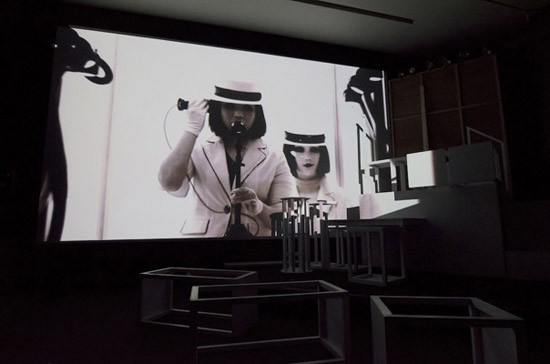 All images unless otherwise noted: Performance still from 1924 at the National Museum of Modern Art, Kyoto, 2011. Courtesy Miwa Yanagi.
All images unless otherwise noted: Performance still from 1924 at the National Museum of Modern Art, Kyoto, 2011. Courtesy Miwa Yanagi.Best known as a photographer addressing images of feminity in a male-oriented society, Miwa Yanagi has over the past year produced a tea ceremony at Kyoto Art Center, Sakuramori; an interactive “old-maid” café as part of the interdisciplinary event Festival/Tokyo 10, Café Rottenmeier; and her latest project, the performance trilogy 1924, investigating the social and cultural impact of Japan’s rapid modernization in the late 19th and early 20th centuries.
Entitled “Tokyo-Berlin,” the first part of the trilogy premiered this July at the National Museum of Modern Art, Kyoto, in conjunction with the exhibition “Moholy-Nagy in Motion.” The second part, “Sea Battle,” premieres this November in association with the 4th Yokohama Triennale; and the third part, “Machine Man,” is scheduled to premiere in mid-2012. Inspired by the art and ideas of Moholy-Nagy as well as the artist Tomoyoshi Murayama (1901-77), who as leader of the 1920s-era experimental art group MAVO articulated a philosophy of “conscious constructivism,” and the theatre producer Yoshi Hijikata, who co-founded the Tsukiji Shogekijo, considered to be Japan’s first Modern theatre, the trilogy also necessarily deals with the aftereffects of the 1923 Great Kanto Earthquake, which caused an estimated 140,000 deaths, and the similarities and divergences between that catastrophe and the 2011 Tohoku Earthquake and Tsunami.
ART iT met with Yanagi to discuss in greater detail her transition from art into theatre, as well as the ideas and references that fed into her conceptualization of 1924.
Interview:
ART iT: I thought we could begin by discussing your experiences leading up to the production of your latest theatre project, 1924 – your most ambitious such project to date. How did it come about?
YM: The 1924 project began with an invitation last year from the National Museum of Modern Art, Kyoto, to produce a performance piece for the museum. When I learned that there were plans underway for concurrent exhibitions of László Moholy-Nagy and Tomoyoshi Murayama, I thought I could integrate elements from the artists’ respective careers into a single theme, and began working on a scenario.
To be honest, at first it barely registered that my scenario begins right after the 1923 Great Kanto Earthquake, with Hijikata’s return from Germany and his establishment, along with Kaoru Osanai, of the Tsukiji Shogekijo, considered to be Japan’s first Modern theatre. While riding the Trans-Siberian Railway on his journey home, Hijikata had stopped in Moscow to see a production at the experimental Meyerhold Theatre, founded by the experimental stage actor, director and producer Vsevolod Meyerhold. There is little extant documentation of Meyerhold’s productions, but it’s easy to imagine that they were completely different from the realist theatre Hijikata had seen to that point, and were the inspiration for his own theatre.
But I was stuck for a long time on how to develop the plot. I was just beginning my research when the March 11 Tohoku Earthquake and Tsunami happened, after which I experienced this sensation of time doubling upon itself, and reconsidered everything I had done to that point. So the direction of the project, and its focus on the 1920s, was strongly influenced by the museum program on the one hand, and the events of March 11 on the other.
ART iT: Can you discuss more specifically how March 11 led you to reconsider your ideas?
YM: This may be a bit of a sentimental way of putting it, but the Tohoku Earthquake and Tsunami prompted me to reconsider my entire life and history, an experience I think is shared by many others as well. Nuclear energy had somehow become accepted as a normal part of everyday life, but I was already a university student when Chernobyl happened, and having seen the effects of such a trauma I could have done more to resist that normalization. Now I feel I must apologize to coming generations for not having been more active.
Ultimately extreme cataclysms and atrocities prompt changes in awareness, and it’s important to understand how these changes come about. For example, there was a long build-up to Japan’s involvement in World War II, beginning with the First Sino-Japanese War of 1894-95, and then the Russo-Japanese War of 1904-05, and then the events surrounding the Second Sino-Japanese War of 1937. I’ve developed an acute interest in understanding what happened in that process.
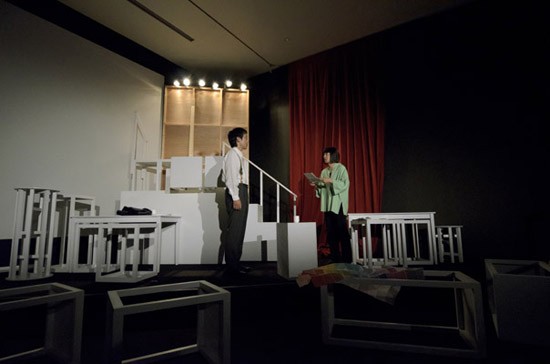
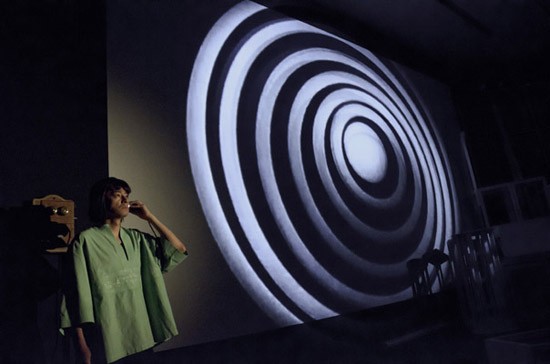
ART iT: This issue deals with the theme of revolutions, which we could think about broadly in terms of any major event that affects people’s lives, and the accompanying changes in how we express and consider ourselves. Would you say Yoshi Hijikata and Tomoyoshi Murayama thought about what they were doing in such revolutionary terms?
YM: I think 1924 was in some sense a time of fulfillment. All sorts of changes in art and society were occurring in parallel. Artists genuinely believed they could lead a social revolution. Everyone was young, and was sustained by a sense of purpose that was based almost entirely on momentum. It was as though the blood was surging into their collective heads. For example, when Murayama went overseas to study he absorbed all at once everything from the Renaissance to Futurism, German Expressionism and Constructivism. Such overseas students somehow exceeded any normal capacity for retention of new information, although I’m not sure how well they digested everything they encountered.
Murayama was certainly the most composed of the MAVO group, since he at least made an effort to digest everything, and even wrote a number of books as a part of that effort. However, I doubt he will be remembered by history as an artist. He is recognized rather for his theatre projects and other activities.
I can relate to this image of Murayama slowly distancing himself from the field of art proper. He probably could not accept the vagueness of art, its primitive aspects. Attempting to synthesize everything he had learned, he ended up producing texts like “The End of Expressionism” and “The Limits of Constructivism,” and that was it for him as an artist. Of course he would later revisit Constructivism, but that was more inspired by his Leftist sympathies than anything else. By the 1930s he had published manga comics, started working in animation and even contributed stories to the Japanese Communist Party’s Akahata (Red Flag) newspaper. He was incredibly gifted. But even as good a draftsman as he was, it was not art so much as philosophy that attracted him. Maybe he simply grew tired of avant-garde posturing that negated the relations between art and thought, or felt it had no effectiveness.
ART iT: So, as with Murayama, does your gradual distancing from art through the pursuit of performance projects result from a similar sense of frustration or ineffectiveness?
YM: It’s not that I feel there is something I can’t achieve through art, so much as it is a case of needing to get outside of the white cube. In fact, more than an issue of space it’s about the overall system of art, in that you need to get beyond the framework in order to see it clearly. Ultimately I felt alienated by the white cube. I’ve exhibited in numerous museums overseas with beautiful white cube galleries, but I never identified with – never felt integrated with – such spaces. However, doing a theatre project and working now in the black box has helped me to develop a new appreciation of the white cube. The whole project has gone really smoothly.
ART iT: Perhaps this is not the most sensitive way to put it, but with the Tohoku Earthquake and Tsunami it seems many people have made themselves the protagonists of responses to the catastrophe. Can the same be said for the Great Kanto Earthquake?
YM: I believe so. In fact it could have been even more widespread. I think people were starting to feel uneasy about the formation of the modern nation state that had been progressing since the Meiji era, but all that was wiped away by the cataclysm. Some 140,000 people lost their lives; it was an extreme tragedy, but even so you have this sense that artists were somehow activated by it. It’s not as if everyday life to that point had been completely harmonious and tranquil in the first place, so perhaps that exacerbated the cataclysmic effect of the earthquake.
ART iT: With the current situation, many people – particularly artists – have been questioning how they can respond to the catastrophe. Did artists following the 1923 earthquake also deal with such issues?
YM: Not really. I think they almost experienced it as a liberation from the restrictions they had experienced to that point. Taking advantage of the chaos that followed the earthquake, artists were able to pursue all kinds of projects they had previously been unable to realize. There were many new works produced, with the Murayama-led MAVO group particularly active. Due to the reconstruction efforts there was also a relaxation of building codes, so Hijikata was able to erect the barrack-style building to house his Tsukiji Shogekijo theatre. This situation of openness continued for several years. However, from 1928 on there were drastic changes leading to a reactionary period and a rapid decline in cultural experimentation, not exclusively related to increasing restrictions of expression as the government moved toward fascism. I’m still researching this phase of the history.
ART iT: Organized in 1988, the Tokyo Metropolitan Art Museum’s “Japan in the 1920s” exhibition made a strong case that the 1920s were the height of Modernism in Japan. But to be honest it’s hard to imagine that the current catastrophe will prompt the birth of a new spirit of initiative.
YM: I think it’s partly because the modes of daily life then and now are completely different. We have been shaken awake from an everyday routine that has been steeped in deep peace. Ashamed of our previous passiveness, we are doing penance for ending up in this situation. The Tohoku Earthquake and Tsunami has put everything into perspective. In 1995 the Great Hanshin Earthquake caused widespread destruction, but there was also a rapid reconstruction effort. Of course, my family home in Kobe was damaged and I never had the luxury of reflecting on the event in more abstract terms. But I feel the situation in Tohoku is more complex.
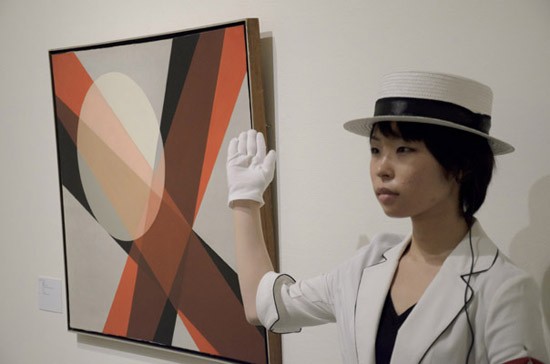
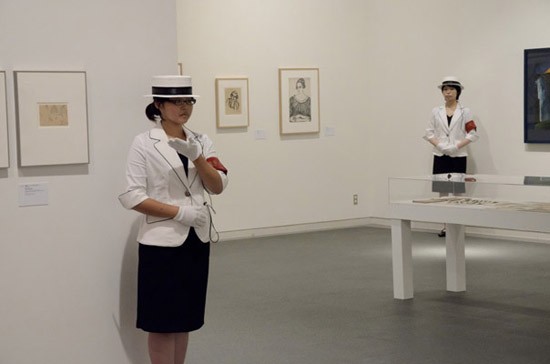
ART iT: Returning to 1924, working with artists from the past – and not limited to those from the 1920s – inevitably entails dealing with the male chauvinism of those eras. Having used women as the basis for all your art projects to date, how have you dealt with that situation?
YM: There were certainly not so many female artists at the time. In 1924, the usherettes are in a sense substitutes for myself. They were present from the very beginning of the creative process, but I’ve only recently begun to see their position clearly. They are narrators – spiritual mediums of a sort – rather than real people. They accompany the male characters, but do not become directly involved in the action. You might say that they’re looking down from above at the men and their zealous crusades. There were actually female artists active during this same period, however few. There’s the writer Fumiko Hayashi, the Russian expatriate Varvara Bubnova, and broader the feminist movement as well.
ART iT: I thought you were attracted by the image of these pioneering women, although of course the Taisho era also witnessed the “Modern Girls” phenomenon.
YM: The usherettes are in fact styled after the Modern Girl look. They were meant to represent a modern image, wearing their suits and speaking in the particular voice of announcers. However, there was absolutely no substance to the Modern Girl concept. The image of the Modern Girl in her Western skirt and hat, drinking soda in the Shiseido Parlor, did not communicate any background information at all about whether these were working women, whether they were married, and so on. Only the image itself became a representation of the era.
In that sense I wanted the usherettes to embody roles that were without substance, without even humanity. Icons without actuality, the Modern Girls had their standards of beauty determined for them by the media, and those standards were determined by the proportions and facial features of Western women. Ayao Yamana’s illustrations are classic examples of this. Then once those standards were in place, they could be used to sell goods like cosmetics. The importation of the Western body coincided with Japan’s attempts to take on the world powers of the time; the modernization of the Japanese body mirrored that of the country as a whole, although entering the war years the image of femininity shifted back to the dutiful wife and mother in her cooking apron.
I thought it would be interesting to combine the Modern Girl image with traditional crafts, which is why I turned to the format of kodan traditional storytelling. I don’t believe there actually were any female kodan storytellers, but the craft itself was integrally part of the world of dandyism, and the stories were greatly popularized during the Meiji era. In that respect it is not so improbable to imagine a storyteller being in a museum. Prior to the establishment of museums in Japan – around the time of the domestic exhibitions for promoting industry – there was no practice of quietly looking at artworks. Rather, there was someone who would explain the works, regardless of whether these were oil paintings or tea ceremony implements. We know from exhibition pamphlets that such guides were present at exhibitions, but because it was an oral practice there is no documentation of what was actually said.
In 2012 when I realize the third part of 1924, I plan to go even further back in time to the Meiji era, exploring the phenomenon of panorama pavilions. There was a panorama pavilion for the First Sino-Japanese War set up in the grounds of Yasukuni Shrine in Tokyo. Taking Manchuria as their subject matter, the paintings in these pavilions showed Japanese people expanded horizons that they couldn’t imagine in their everyday lives. It seems there were quite a number of artists who made such paintings. Then by the time of the Russo-Japanese war photographic panoramas became extremely popular. This is in fact material I had been researching prior to beginning work on 1924, and it was only because of Moholy-Nagy and Murayama that I warped forward to the Taisho era.
ART iT: I notice that all your performances seem to deal with artists. Is this intentional, and something you plan to develop further?
YM: I do not plan to work only with artists. I would like to branch out to any number of topics. It’s just that I’m still going through a learning process of how to express myself through theatre.
This allows me to reconsider art from something approaching an objective distance. It’s easy to compare the modernization of art and the modernization of theatre. In the case of art, the modernization was implemented by the nation. Okakura Tenshin and Ernest Fenellosa were both appointed to their positions by the state, and it was they who systematically sifted through and selected aspects of foreign visual culture to bring to Japan. Because Fenellosa was so talented, this can hardly be considered a misfortune for Japan, but the system itself has not changed at all since then.
The modernization of theatre was drastically different, driven by the private individuals and developed in a way similar to oral traditions without any particular discipline. This kind of grassroots development I find to be really interesting. In the case of theatre, people were taking impassioned, individual responsibility for introducing new approaches from overseas.
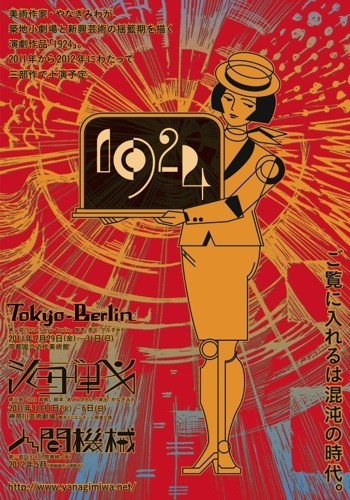
Poster for the performance trilogy 1924. Courtesy Miwa Yanagi.
ART iT: How about your own interest in new modes of expression? For example, when Hijikata saw Meyerhold’s work it was his first ever encounter with abstract theatre. Do you have any desire to similarly produce something nobody has ever seen before?
YM: I’m not seeking that kind of newness. In fact I prefer realistic theatre. Of course I admire things like the Bauhaus Theatre Workshop and Oskar Schlemmer’s Triadisches Ballett (1922), but I have no desire to emulate them. Even in an art museum, I’m following a somewhat conventional dialogic structure.
In that sense perhaps I am intractably not a Modernist. According to the literature, when Hijikata staged Reinhard Goering’s Sea Battle (1917), nobody could understand a thing, because the dialogue was delivered too quickly, and included lists of words that made no sense whatsoever, and because the sound effects were too loud, and because of the three-dimensional stage, and all these other elements that the audience was encountering for the first time and which surpassed the limits of their understanding. In particular, the three-dimensional stage must have been shocking for audiences who had only ever seen stages with painted backdrops. With the audience leaving the theatre confused and silent, the only thing that could be said about the production was that it was new. Only someone like Murayama could respond to it with enthusiasm, although how much even he understood is unclear. Incorporating Sea Battle into 1924 as a play within the play, I have struggled with how to make the elements that I reference easier to understand. Staging Sea Battle today would not make any sense, and to do so is not my intent. I’m not convinced that things that confound understanding are necessarily shocking.
